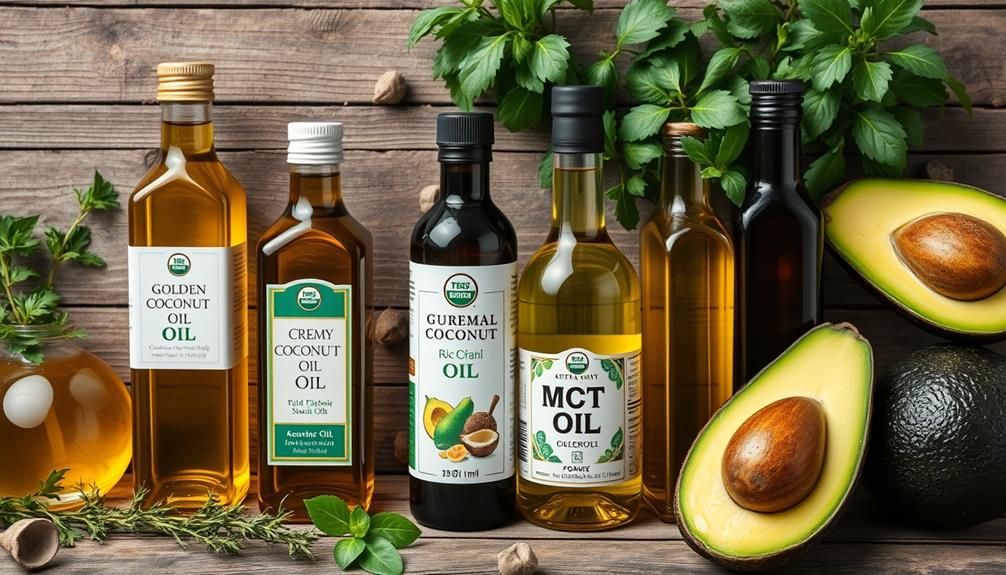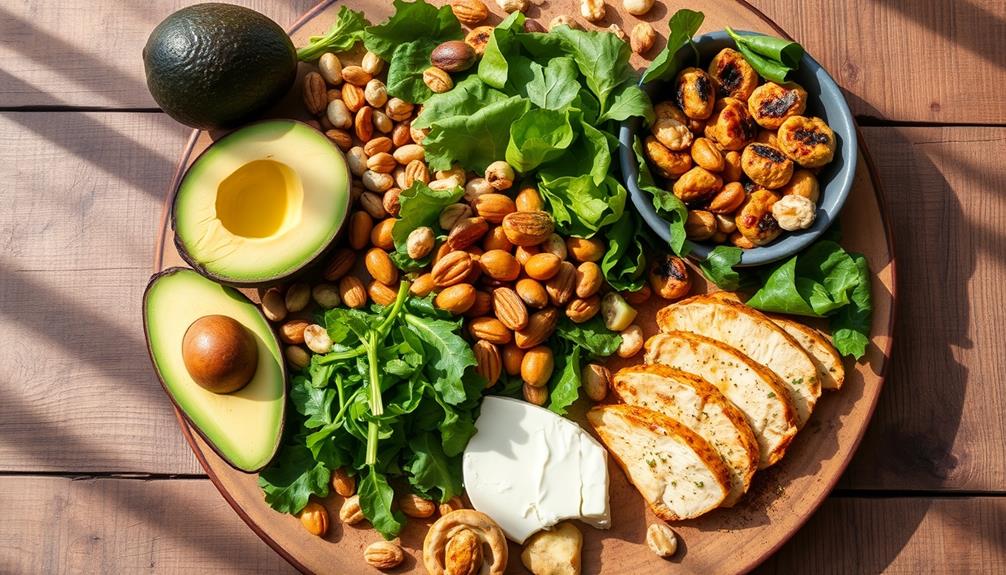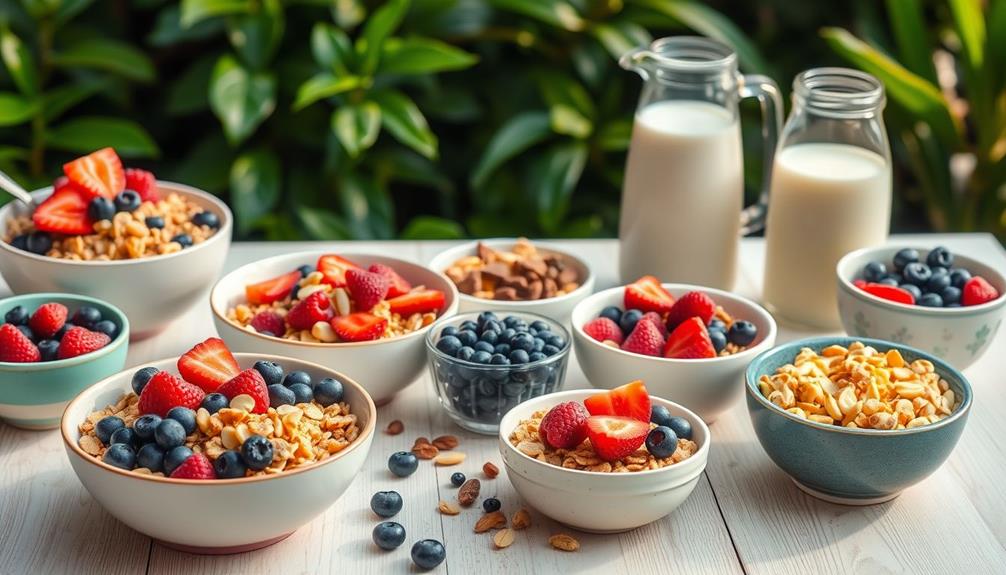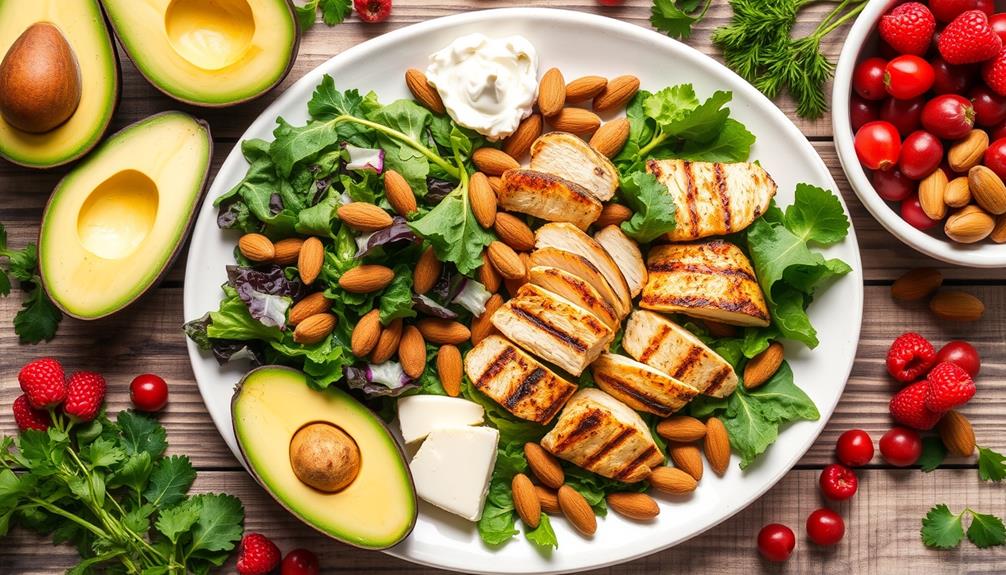When you're on a keto diet, your best bets are oils high in healthy fats and low in carbs. Coconut oil is excellent due to its medium-chain triglycerides (MCTs), which boost energy. Extra virgin olive oil is fantastic for dressings and light cooking because of its heart-healthy monounsaturated fats. Avocado oil shines with its high smoke point, perfect for high-heat cooking. Avoid oils high in omega-6, like vegetable and canola oil, to keep inflammation at bay. Curious about more options and tips for incorporating these oils into your meals?
Key Takeaways
- Extra Virgin Olive Oil: Rich in monounsaturated fats and antioxidants, ideal for dressings and low to medium-heat cooking.
- Coconut Oil: High in MCTs, boosts energy and metabolism, suitable for baking and frying.
- Avocado Oil: Contains heart-healthy fats with a high smoke point of 500°F, perfect for high-heat cooking.
- MCT Oil: Concentrated source of MCTs that quickly converts to ketones, enhancing energy and ketosis.
- High Oleic Sunflower/Safflower Oil: Offers a neutral taste and healthy fatty acid profile, suitable for various cooking methods.
Overview of Keto Oils
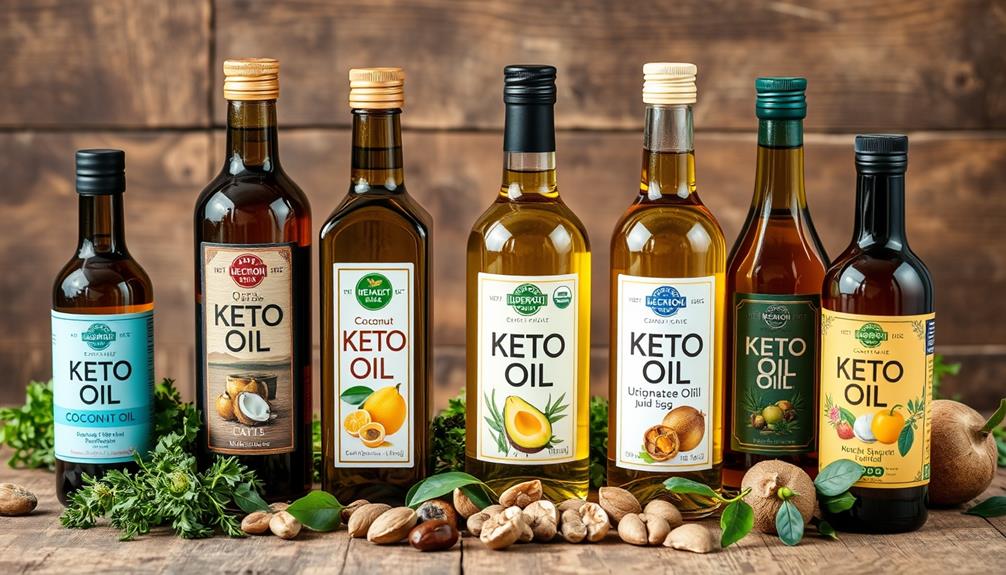
When it comes to choosing oils for the keto diet, what should you keep in mind? First, you need oils that are high in fat and low in carbs to maintain ketosis. Coconut oil is a fantastic option, as it's rich in medium-chain triglycerides (MCTs) that can boost your energy and metabolism. You'll find it's a popular choice for cooking on keto. Another great oil for the keto diet is avocado oil, which is high in monounsaturated fats and also has a high smoke point for cooking. Olive oil is also a good choice for its high healthy fat content. When it comes to dairy, look for the best ketofriendly heavy cream to use in your coffee or to make keto-friendly desserts.
Additionally, incorporating oils that support overall health, such as those recommended for a balanced diet, can enhance your keto journey, helping to guarantee you're getting essential nutrients while reducing inflammation foods to avoid.
Extra virgin olive oil is another excellent pick. It's loaded with monounsaturated fats and antioxidants, making it ideal for dressings and low to medium-heat cooking.
However, if you're frying, consider avocado oil, which has a high smoke point of around 500°F (260°C) and also provides heart-healthy monounsaturated fats.
Be cautious and avoid oils high in omega-6 fatty acids, like vegetable, canola, and soybean oils. These can promote inflammation and upset the balance of omega-3 intake, which is vital for your overall health on a keto diet.
Sticking to these keto-friendly oils guarantees you're fueling your body with the right fats while reaping the benefits of the diet.
Top Cooking Oils for Keto
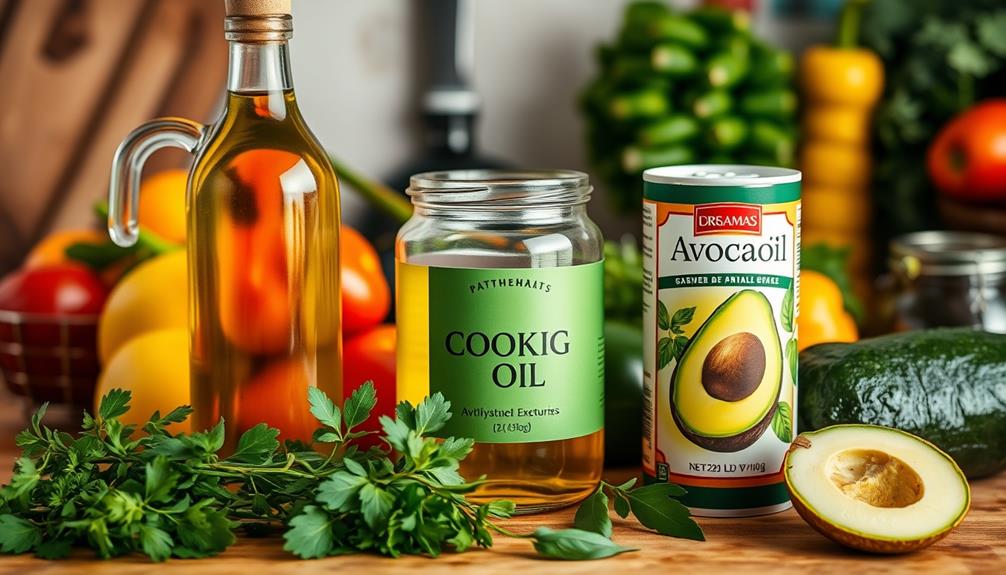
When choosing the best cooking oils for your keto diet, consider their health benefits and how they fit into your cooking techniques.
Oils like extra virgin olive oil and coconut oil not only enhance flavor but also support your keto goals.
Additionally, oils rich in antioxidants, such as cranberry juice consumption, can provide health benefits that align with your dietary needs.
You'll also want to know which oils to avoid to keep your diet on track.
Health Benefits of Oils
Incorporating healthy oils into your keto diet can greatly enhance both flavor and nutritional benefits. Oils like extra virgin olive oil and avocado oil are rich in monounsaturated fats, which support heart health and improve cholesterol levels.
Additionally, certain essential oils, such as peppermint oil, can offer digestive support, which is beneficial when adapting to a low-carb lifestyle. Coconut oil, packed with medium-chain triglycerides (MCTs), can enhance ketone production and provide quick energy, helping you maintain ketosis effectively.
Using these oils not only boosts your meals but also aids in nutrient absorption. The fats in avocado and olive oil help your body absorb fat-soluble vitamins A, D, E, and K, promoting better nutrient utilization in your low-carb diet.
Furthermore, extra virgin olive oil is loaded with antioxidant properties and anti-inflammatory compounds, which contribute to overall health and may reduce the risk of chronic diseases.
Don't forget about flavor! Diverse oils like hazelnut and sesame can elevate your keto dishes while providing essential fatty acids, ensuring your meals are both satisfying and varied.
Cooking Techniques and Tips
Cooking techniques and tips are essential for maximizing the benefits of oils in your keto diet. When you're frying or engaging in high-heat cooking, opt for oils with a high smoke point, like avocado oil (around 500°F) and refined coconut oil (up to 450°F). These options help prevent oxidation and maintain nutrient integrity, ensuring you get the best health benefits from your meals.
Additionally, understanding the brewing methods in coffee can enhance your overall culinary experience, as they also involve careful temperature management.
For low to medium-heat cooking, extra virgin olive oil is your go-to. It's perfect for salad dressings and marinades, providing heart-healthy monounsaturated fats and antioxidants. To enhance flavor and nutritional value, consider combining oils. Mixing olive oil with avocado oil not only boosts taste but also offers a diverse range of fatty acids, including omega-3 fats.
Remember to store your cooking oils in dark, cool places to preserve their freshness and quality. Also, avoid reusing oils after frying, as this can lead to harmful compounds forming, which detracts from your health benefits.
Oils to Avoid
While choosing the right oils can enhance your keto meals, it's just as important to know which ones to steer clear of. Oils to avoid include vegetable oils like soybean, corn, and canola oil. These are high in omega-6 fatty acids, which can promote inflammation and disrupt your body's omega balance.
Additionally, understanding the importance of common financial terms can help you budget effectively for your keto diet. Sunflower oil is another one to skip; it's often highly processed and lacks the nutritional benefits you're looking for on a keto diet.
Refined oils, especially those that are partially or fully hydrogenated, should also be avoided. These contain unhealthy trans fats and offer little regarding nutritional value.
While peanut oil has some monounsaturated fats, it's packed with omega-6, which can lead to imbalances if overconsumed. Similarly, sesame oil, particularly in its unrefined form, should be used sparingly due to its high omega-6 content.
Instead, focus on incorporating healthy fats like unrefined coconut oil and olive oil into your meals. By avoiding these detrimental oils, you'll be setting yourself up for greater success on your keto journey.
Oils to Avoid on Keto

When following a keto diet, steering clear of certain oils is essential for maintaining your health and achieving your dietary goals. Oils to avoid include vegetable oil, canola oil, soybean oil, corn oil, and sunflower oil.
These oils are often highly processed and contain high levels of omega-6 fatty acids, which can promote inflammation and disrupt the omega balance in your body. Additionally, opting for healthier fats can enhance your overall well-being and support your dietary requirements, similar to how choosing the best heat pumps can optimize home comfort.
Vegetable oil is a common choice in many households, but it can lead to health issues due to its inflammatory properties.
Canola oil, often derived from genetically modified crops, is low in nutritional value and isn't recommended for a ketogenic diet. Similarly, soybean oil is linked to various health problems and should be avoided.
Corn oil lacks significant health benefits and is highly processed, making it an unsuitable option.
Sunflower oil, like the others, is high in omega-6 fatty acids and can lead to inflammation.
Health Benefits of Keto Oils
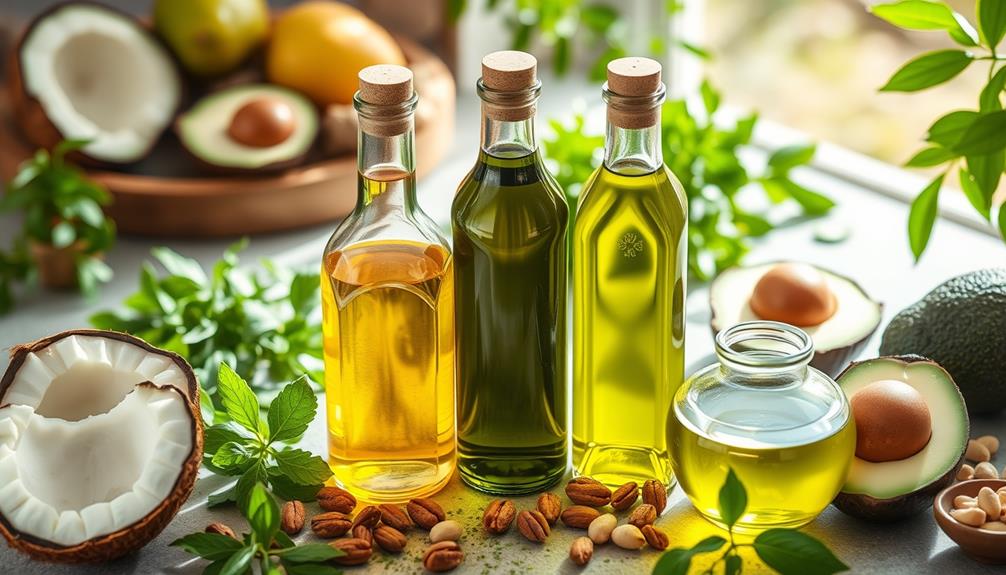
Choosing the right oils can greatly enhance your keto diet, providing numerous health benefits that support your weight loss goals and overall well-being. Keto oils, rich in healthy fats, promote fat oxidation and increase satiety, helping you reduce overall calorie intake. Oils high in monounsaturated fats, like extra virgin olive oil and avocado oil, can improve cholesterol levels and boost heart health.
Incorporating medium-chain triglycerides (MCTs) from coconut oil or MCT oil can elevate your energy levels and enhance ketone production, making it easier to shift into ketosis. Additionally, the antioxidants and anti-inflammatory properties found in oils like olive and avocado oil contribute to overall health and help combat oxidative stress. Proper fat intake from these keto oils is essential for the absorption of important fat-soluble vitamins (A, D, E, and K), ensuring you get the nutrients you need on a low-carb diet.
| Oil Type | Health Benefit | Key Component |
|---|---|---|
| Extra Virgin Olive Oil | Improves cholesterol levels | Monounsaturated fats |
| Avocado Oil | Supports heart health | Healthy fats |
| Coconut Oil | Boosts energy levels | Medium-chain triglycerides |
| MCT Oil | Enhances ketone production | MCTs |
| Flaxseed Oil | Provides essential omega-3s | Healthy fats |
Cooking Tips for Keto Oils
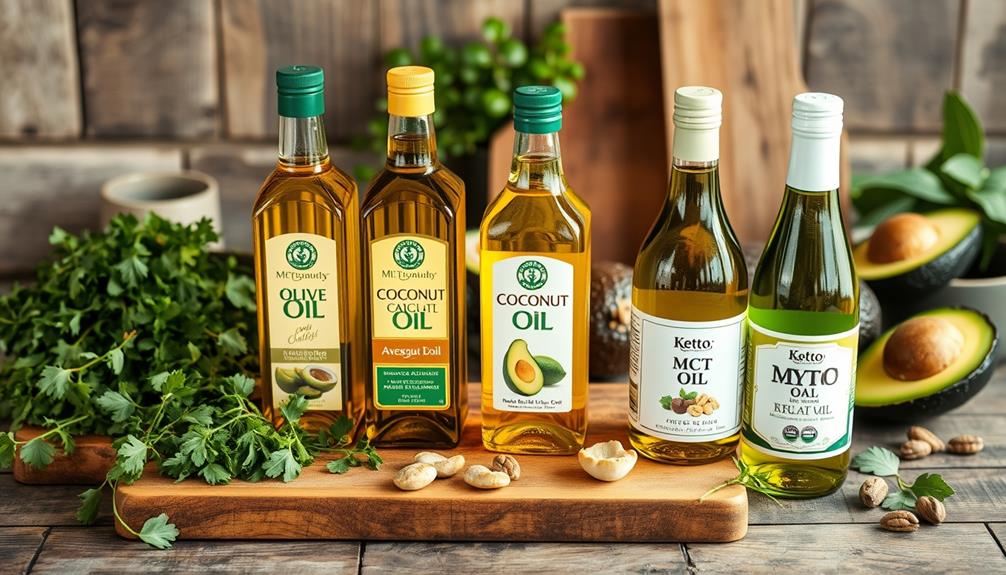
When cooking with keto oils, it's crucial to choose those with high smoke points like avocado and refined coconut oil to keep your meals healthy.
Sugar overload can lead to health issues like obesity and diabetes, so opting for healthier oil choices is significant.
You can also enhance flavors by pairing oils, such as mixing olive and avocado oil for a richer taste.
Remember to store your oils properly and avoid reusing them to maintain their quality and benefits.
High Smoke Point Oils
Cooking with high smoke point oils is essential for anyone on a keto diet. These oils are perfect for high heat cooking, allowing you to fry, sauté, and roast without producing harmful compounds. Using oils with high smoke points not only guarantees safety but also helps retain the nutritional benefits of the healthiest oils.
Here's a quick comparison of some top choices for high smoke point oils:
| Oil Type | Smoke Point (°F) |
|---|---|
| Avocado Oil | 500 |
| Coconut Oil | 350 (unrefined) / 450 (refined) |
| Ghee | 450 |
| Lard | 370 |
| Tallow | 400 |
Incorporating these cooking fats into your meals allows you to enjoy rich flavors while sticking to your keto diet. Animal fats like lard and tallow not only offer high smoke points but also add unique flavors to your dishes. By choosing the right oils, you can enhance your cooking experience while maintaining the health benefits of the keto lifestyle.
Flavor Pairing Techniques
Flavor pairing techniques can greatly enhance your keto meals, making them not only nutritious but also delicious. Start by experimenting with oil combinations, like blending olive oil and avocado oil. This can elevate both flavor and health benefits, thanks to their complementary fatty acid profiles and unique flavor profiles from different regions known for quality.
Additionally, exploring coffee varieties can inspire new flavor inspirations for your ketogenic dishes. Flavored oils, such as garlic-infused olive oil or chili oil, can also be a game-changer. They'll boost the taste of your salads and marinades without adding extra carbs, keeping your meals enjoyable.
When cooking, don't forget the power of finishing oils. Drizzling a rich oil like hazelnut or walnut oil over roasted vegetables or meats can add depth and richness, enhancing the overall flavor.
For high-heat cooking methods, use oils with a high smoke point, like avocado oil, to guarantee robust flavors while preserving healthy fats.
Proper Storage Methods
To keep your keto oils fresh and flavorful, proper storage is essential. By following a few simple guidelines, you can maintain the quality and extend the lifespan of your oils.
| Storage Tips | Benefits | Key Practices |
|---|---|---|
| Store in a dark place | Prevents oxidation | Use a pantry or cupboard |
| Use dark glass containers | Protects from light | Choose opaque bottles |
| Seal tightly after use | Minimizes air exposure | Always close containers well |
Keep your oils away from heat sources and direct sunlight, as high temperatures can cause them to go rancid quickly. Check the expiration date regularly and discard any oils that have an off smell, taste, or appearance. Proper sealing of containers after each use is vital for minimizing oxidation, ensuring your oils maintain their freshness. By prioritizing these storage methods, you'll enjoy high-quality oils that elevate your keto cooking experience. Remember, the right storage techniques not only enhance the flavor but also contribute to the overall health benefits of your diet.
Integrating Oils Into Your Diet

Integrating a variety of oils into your diet can elevate your cooking while helping you meet your fat intake goals on a keto diet. By incorporating oils like extra virgin olive oil, avocado oil, and coconut oil, you can enhance flavor and guarantee you're getting a good source of fat.
Additionally, using oils can support your overall health by providing essential fatty acids and antioxidants, which are important for a balanced diet. For high-heat cooking methods, choose oils with a high smoke point, such as avocado oil (approximately 500°F) or refined coconut oil (up to 450°F). These oils are perfect for frying and sautéing.
Don't hesitate to experiment with different oils in dressings and marinades. A combination of olive oil and balsamic vinegar can enrich your salads while maintaining keto-friendly macros.
Just remember to keep your oils stored in dark, cool places to preserve their freshness and prevent oxidation, which can diminish their health benefits. Consider incorporating an easy composting technique to recycle your kitchen waste, which can further enhance your cooking experience.
As you focus on integrating these oils into your meals, be mindful of your overall fat intake. Aim for 70-80% of your daily calories from fats, and limit pure fat or oil consumption to 3-4 tablespoons daily to maintain a balanced keto diet.
Ideal Fat Sources for Keto
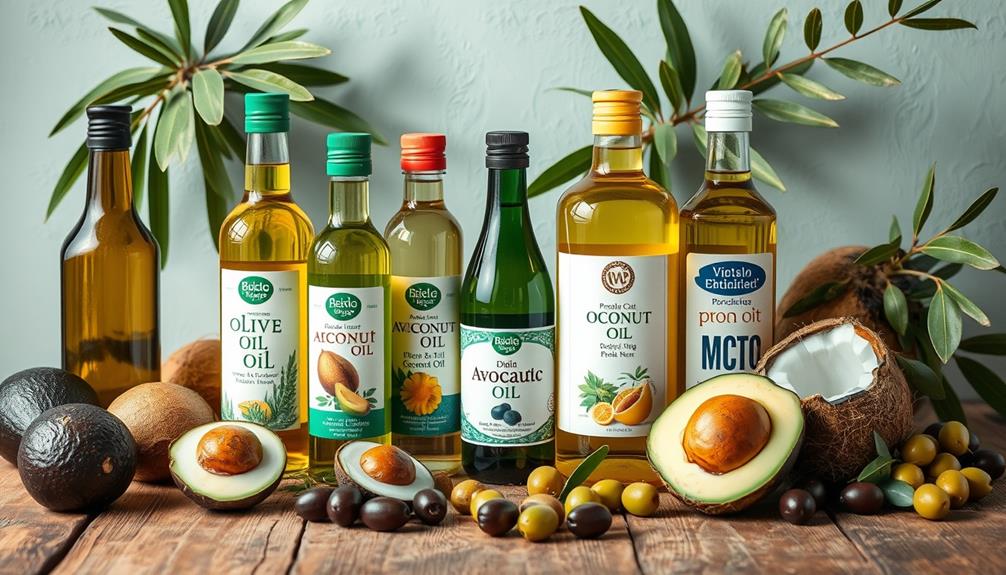
Choosing the right fat sources is key to successfully maintaining a ketogenic diet. You should aim for 70-80% of your daily energy intake to come from healthy fats, primarily high in saturated fat and monounsaturated fats. These fats are suitable for keto because they help maintain ketosis and promote fat burning.
Incorporating fats like butter into your diet can enhance flavor and texture while also providing essential vitamins butter is a source of vitamins.
High-quality oils like extra virgin olive oil, avocado oil, and refined coconut oil are excellent choices. These oils not only provide a favorable fatty acid profile but also offer health benefits, such as supporting heart health and improving cholesterol levels.
Saturated fats from sources like coconut oil and animal fats, such as lard and tallow, serve as a quick source of energy and assist your body in adapting into ketosis.
When using these fats and oils, pay attention to your overall intake to avoid excessive consumption. A daily limit of 3-4 tablespoons of pure fat or oil is recommended.
Focus on using minimally processed options and explore different cooking methods to incorporate these ideal fat sources into your meals. This way, you'll support your keto journey effectively and deliciously!
Omega-6 and Omega-3 Balance

Maintaining a proper balance of omega-6 and omega-3 fatty acids is essential for your overall health while on a ketogenic diet. You need to be aware that excessive omega-6 intake, often from high omega-6 oils like corn, soybean, and sunflower oils, can disrupt your digestive health and lead to inflammation.
Ideally, your omega-6 to omega-3 ratio should be around 4:1 to 1:1, but many people exceed this considerably, which can negatively affect your metabolic health.
To achieve a healthy balance, consider incorporating omega-3 sources into your diet. Fatty fish, such as salmon and mackerel, are excellent choices that provide beneficial omega-3s. If you're looking for plant-based options, flaxseed oil and walnuts are great alternatives rich in omega-3 fatty acids.
Aim for about 1 teaspoon (5 grams) of each type of fatty acid daily to support peak health. By consciously reducing high omega-6 oils and boosting your intake of omega-3-rich foods, you can maintain a healthier balance that promotes overall well-being while adhering to your ketogenic lifestyle.
Recommended Oils for Cooking

When cooking on a ketogenic diet, selecting the right oils can markedly impact your health and culinary experience.
Extra Virgin Olive Oil stands out for its rich monounsaturated fats and polyphenols, making it perfect for both cooking and dressings while providing numerous health benefits.
If you're into baking or frying, Coconut Oil is your go-to due to its high saturated fat content and medium-chain triglycerides (MCTs), which can help boost metabolism and support ketosis.
For high-heat cooking, Avocado Oil is a fantastic choice, boasting a high smoke point of around 520°F (260°C) and delivering heart-healthy fats.
If you're looking for quick energy boosts, MCT Oil is a concentrated source of medium-chain triglycerides that rapidly converts to ketones, ideal for your keto recipes.
Lastly, High Oleic Sunflower Oil and High Oleic Safflower Oil are excellent alternatives with their neutral taste and healthy fatty acid profiles, making them suitable for various cooking methods.
Frequently Asked Questions
What Is the Best Oil to Use on Keto?
When choosing oil, consider your cooking method and health benefits. Extra virgin olive oil offers great flavor and nutrients, while coconut oil provides energy-boosting MCTs. Avocado oil's high smoke point makes it ideal for roasting.
Is Coconut Oil or Olive Oil Better for Keto?
So, you're pondering the great oil debate? Coconut oil's a tropical delight for energy, while olive oil's your heart-friendly companion. Mix 'em up, and you'll have a culinary masterpiece that even taste buds can't resist!
Can You Eat Oil on a Keto Diet?
Yes, you can eat oil on a keto diet. Oils are a great source of healthy fats, helping you reach your daily caloric intake while promoting ketosis. Just choose high-quality options and monitor your total fat consumption.
Does Olive Oil Break Ketosis?
No, olive oil won't break ketosis. It's a pure fat source with zero carbs. Incorporating it into your meals can enhance flavor and support your fat intake while keeping your carbohydrate levels low. Enjoy it!
Conclusion
Incorporating the right oils into your keto diet can transform your meals into culinary masterpieces! By selecting healthy fats like olive oil, coconut oil, and avocado oil, you're not just enhancing flavor but also boosting your wellness. Remember to avoid oils high in omega-6s, as they can derail your progress. With these tips, you'll elevate your cooking and enjoy the myriad benefits of keto oils. So, go ahead—make your kitchen the ultimate keto haven!
